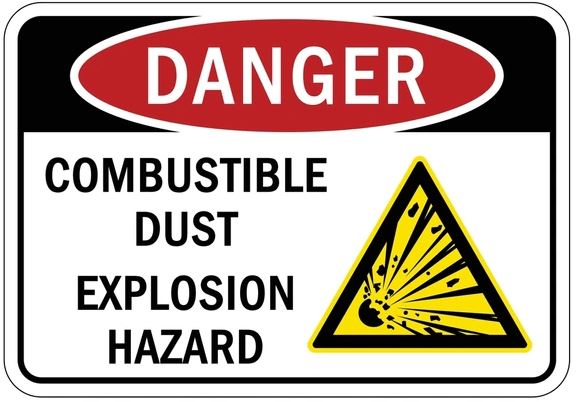The presence of explosive dust presents a real danger in a manufacturing environment. A well-designed dust collection system is a critical part of any plan to reduce the hazards of explosive dust. In this blog, I will discuss the key design criteria for an explosive dust collection system.
Capture Velocity
 The first key design criteria for an explosive dust collection system involves determining the necessary air velocity to effectively capture dust particles. According to the American Conference of Governmental Industrial Hygienists, recommended capture velocities span a broad spectrum from 50 FPM to 2000 FPM.
The first key design criteria for an explosive dust collection system involves determining the necessary air velocity to effectively capture dust particles. According to the American Conference of Governmental Industrial Hygienists, recommended capture velocities span a broad spectrum from 50 FPM to 2000 FPM.
Two critical elements influence the selection of appropriate capture velocity: the dust particles’ weight and their velocity. For lighter materials like paint spray or flour dust, lower velocities suffice. Whereas heavier materials such as metal turnings or blast dust demand higher velocities. Particles moving slowly, like those from container filling operations, need lower capture velocities, while those from moving conveyer belts require increased capture velocities. Beginning system design with the correct capture velocity prevents issues of under sizing an explosive dust collection system.
Transport Velocity
The second key design criteria for an explosive dust collection system involves calculating and sustaining proper transport velocity throughout the ductwork network. Standard duct velocity might suffice for moving lighter or drier dust particles through the entire ductwork system to the collector. However, when dealing with heavy dust particles, higher transport velocities become necessary to avoid settling or clogging issues.
When an explosive dust collection system features multiple capture points, the ductwork must include branches for each collection area. Ensuring consistent transport velocity across these branches and collection points is crucial. To maintain adequate transport velocity for collection points beyond the initial one, proper transitions must be implemented. Without these transitions, some capture points will lack sufficient airflow to generate the required capture velocity.
Total Static Pressure
Air resistance occurs at every capture point, transition, branch, and duct elbow. Each ductwork component has its specific air resistance coefficient based on its geometric properties. By combining these resistance coefficients with transport velocity calculations, the system’s total static pressure can be determined.
Total static pressure represents one of two essential parameters for selecting the appropriate fan size for an explosive dust collection system. If total static pressure is underestimated, the selected fan will be undersized, resulting in capture velocities below required levels.
Explosion Mitigation Equipment
The downside to collecting explosive dust is that it creates an extremely high concentration within the dust collection system. To prevent and protect the dust collection system from an explosion or fire, there are several equipment options that can be used:
- Active and passive abatement. This type of equipment is used to abate, detect, and extinguish sparks before they can cause a fire or explosion.
- Explosion venting. These are special designed panels that will rupture in the event of an explosion. They minimize the damage and direct the fireball to a safe area.
- Active and passive isolation. When an explosion or fire occurs inside the dust collector, isolation equipment will prevent the explosion or fire from spreading inside the dust collection system or to the building containing the dust collector.
- Fire suppression. Gas or chemical suppressants are released inside the dust collector when a fire is detected.
Depending on the type of explosive dust and the system design, one or all these options may be required to protect the dust collection system. When we are designing an explosive dust collection system, we rely on the expertise of Donaldson to recommend the best way to prevent and protect the system from explosions and fire.
Conclusion
Designing an explosive dust collection system is a complex process. One wrong calculation can have a disastrous outcome. At Eldridge, we think the design of such a critical system requires an extra level of certainty. That is why we use a proprietary fluid flow software program to guarantee that the capture velocity, transport velocity and total static pressure are correct for the application.
If you think that your dust collection system is inadequate for the effective capture of explosive dust, contact an Eldridge Ventilation Expert. We will redesign your dust collection system to provide a healthy and safe environment for people, products and processes.
